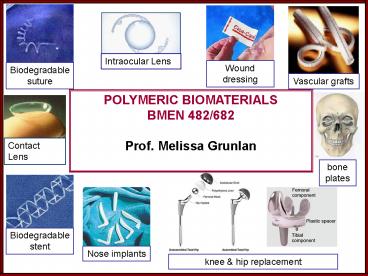Contact Lens - PowerPoint PPT Presentation
1 / 23
Title:
Contact Lens
Description:
Wound dressing Vascular grafts POLYMERIC BIOMATERIALS BMEN 482/682 Prof. Melissa Grunlan Contact Lens Biodegradable suture bone plates Intraocular Lens – PowerPoint PPT presentation
Number of Views:267
Avg rating:3.0/5.0
Title: Contact Lens
1
POLYMERIC BIOMATERIALS BMEN 482/682 Prof.
Melissa Grunlan
Contact Lens
bone plates
knee hip replacement
2
What are BIOMATERIALS?
materials that can function as
3
What is a Metal?
- Which elements are metallic?
4
(No Transcript)
5
What is an alloy?
- Examples in biomaterials
- - Titanium alloy (Ti-6Al-4V)
- 90 Ti, 6 Al, 4 V low amounts of H, Fe, N,
C - femoral stem
- - Stainless steel 316L
- 63 Fe, 18 Cr, 13 Ni low amounts of N, Mn,
Mo, P, Si, S, and C - femoral head (occasionally)
6
Metals and Alloy Devices
Advantages Strong Tough Ductile
Disadvantages Corrosion Dense (high
weight) Difficult to process/fabricate
Examples Joint replacement Dental root
implants Orthopedic fixation bone plates
Knee replacement
Shoulder replacement
Dental implant (root)
Bone plate
7
What is a Ceramic?
- Example in biomaterials
- Aluminum Oxide/ Alumina (Al2O3)
- Femoral ball liner (occasionally)
- Acetabular cup liner (occasionally)
8
Ceramic Devices
Advantages Biocompatible May be bioactive
Disadvantages Very brittle (fracture)
(these terms will be defined later)
Examples Dental implant (looks like
bone/tooth) Some joint replacement articulating
surfaces Bone cement filler to encourage bone
in-growth (older patients)
Dental implant (root)
Elbow joint
Hip joint
Cemented hip joint
9
What is a Polymer?
- Example in biomaterials
- UHMWPE
- -CH2-CH2-
- MW 2-3 million g/mols (n 107,143)
- acetabular cup liner (most common)
n
10
Polymer Devices
Disadvantages Not as rigid Not as strong May
soften in the body due to water uptake
Advantages Easy to fabricate Low density (low
weight) May be biodegradable
Examples Some joint replacement articulating
surfaces Spinal cages Biodegradable bone plates
for low load regions Biodegradable sutures
Bone plates
Hip joint
Spinal cage for spine fusion
11
BIOMATERIALS CAN BE USED TO FORM
Exoprothesis external Endoprothesis -
internal
Artificial Liver
12
Useful Definitions
- Biocompatible
- the ability of a material to perform with an
appropriate ____________________in a specific
application - Biomaterials must be biocompatible, but the
level or extent of biocompatibility varies
for biocompatible materials. - _____________________determines
biocompatibility.
13
Useful Definitions
Foreign Body Reaction host response to
biomaterial
some biomaterial
14
Useful Definitions
Bioinert Bioactive - For example, bioactive
glasses stimulate bone tissue growth
Cement contains bioactive glass
Cemented hip joint
15
Useful Definitions
Biodegradable Undergoes degradation in the
body - Degradation involves bond breaking -
Degradation products are harmless and can be
secreted naturally
water
Lactic acid
PLLA bone plates
16
Mechanical Properties Why is important to study
for all biomaterials?
Determines how well it will work (or not work)
for a given device. One major factor is the
modulus of the material.
metal
polymer
polymer
Toe implant
elastomer
hydrogel
hydrogel
17
What is a modulus?
Material E (GPa)
Silicone Elastomer (Rubber) 0.002
Polyethylene (PE) 0.69
Poly(methyl methacrylate) (PMMA) 2.2-3.2
Cortical Bone 17- 24
Cancellous Bone 0.1 4.5
Glass 73
Gold 77
Ti-6Al-4V 114
Stainless Steel 316L 190
Tantalum 190
Haynes-Stellite 21 (Cast Co-Cr-Mo) 210
Aluminum oxide 380
Diamond 700-1200
What is a GPa? 1GPa 103 MPa 109 N/m2
145,038 psi
18
Mechanical Properties of Biomaterials
- Must not permanently deform (or fracture) under
physiological loads (see THR images) - Mechanical properties can change the host
response (and thus device success). - e.g. stress-shielding and restenosis
- Load depends on device
- Modulus (E) depends on material
structure/composition/-defects/impurities
19
Mechanical Properties of Biomaterials
- CASE 1 Modulus of device gt Modulus of tissue
higher modulus of the bone plate vs. the
surrounding bone tissue leads to stress shielding
? bone loss ? implant loosening ? possible
fracture
Stainless Steel 316L (bone plate) E 193
GPa Cortical Bone 17-24 GPa
20
Mechanical Properties of Biomaterials
- CASE 2 Modulus of device lt Modulus of tissue
Can only be used in low load-bearing
applications (e.g. wrist not femoral fractures)
PLLA (bone plate) E 2.7 GPa Cortical Bone E
17-24 GPa
21
Mechanical Properties of Biomaterials
- CASE 1 Modulus of device gt Modulus of tissue
- Restenosis re-blocking of artery due to the
formation of neointima thick smooth muscle
tissue inside lumen
Stainless Steel 316L (Stent) E 193 GPa Artery
E 0.1 MPa
22
Mechanical Properties of Biomaterials
- Biodegradable Polymer Stents
- Present long enough for vessel to
- re-model and then it dissolves
- Can be drug-loaded
- Minimize restenosis
- Disadvantage recoil (collapse)
PLLA (Stent) E 2.7 GPa Artery E 0.1 MPa
LASER LACE This biodegradable polymer stent
was cut by an ultrafast laser.
23
POLYMERS IN OPHTHALMICS
- Intraocular Lens replace opaque crystalline
lens (cataract) of the eye
Inflexible IOL Tg 105 ?C Rigid Larger
incision needed
Foldable IOL Tg (PDMS) -125 ?C
Flexible Smaller incision
PDMS PMMA
Silicone Acrylates
PMMA































